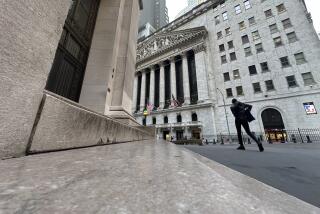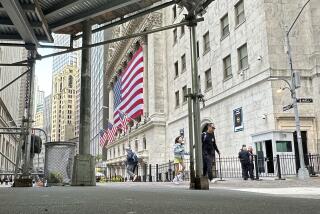Dollar Rebounds in U.S. as Dow Closes Off 50.56 : Late Rally Saves Index From 100-Point Drop
NEW YORK — Stocks seemed destined for another bruising fall on Tuesday, but dramatically regained their balance in the final half-hour of trading to close with the Dow Jones industrial average off 50.56 points at 1,963.53.
The Dow, which had chugged steadily uphill for five consecutive sessions, was down a dizzying 100 points at mid-afternoon before the turnaround began. Trading volume, a relatively tranquil 176.04 million shares on Monday, surged to 227.84 million shares.
The market’s swoon began with the opening bell amid concern about continuing weakness in the dollar and bond markets, as well as reports of another adverse prediction from market analyst Robert Prechter of the Elliott Wave Theorist newsletter. But some analysts said that the drop was not unexpected after five days of rising prices and saw signs of stability in the market’s resilience.
“All things considered, the day closed on a positive note,” said Philip Erlanger, chief technical analyst with Advest Inc. in Hartford, Conn.
Market Unruffled
Meanwhile, the New York Stock Exchange began pulling back from its attempts to limit so-called program trading, the controversial computer-based techniques that some critics have blamed for exacerbating the market’s collapse.
The exchange said that, as of the beginning of trading today, it has withdrawn its request that member firms not initiate any program trades. But the Big Board stopped short of allowing firms to again execute such trades through its computerized trading link known as “Dot.”
In a statement, the exchange said that while the market is beginning to “stabilize, it is prudent to return to normal trading procedures in stages.”
Critics have argued that program trading increases the volatility of the market by increasing the volume of trades when prices begin to rapidly rise or fall. Program trading accounts for about 20% of all New York Stock Exchange trades, officials say.
Traders at firms that engage in program trading shared exchange officials’ view that the move will leave the market unruffled. “It’s a non-event,” said Bob Gordon, president of Twenty-First Securities in New York.
Program Trading’s Role
But others contended that additional program trading could add volatility while the market is still fragile. “I’m surprised and not at all pleased,” said Michael Metz, vice president and market analyst at Oppenheimer & Co. in New York.
“This is certainly not the thing to do until we have found out what role program trading played in the fall,” said Advest’s Erlanger. “They’re buckling under to the most powerful players on the Street, who make all the money from this.”
The New York Stock Exchange declined to say when it would allow firms to resume their hookups with the automated stock trading system.
Even with the exchange’s limits on such activities, some investment firms have been making program trades in recent days. Analysts said program trading was again in evidence on Tuesday and contributed to the market’s decline.
Also playing a part in the early trading were declines on European exchanges. In London, the Financial Times 100-share index fell 69.8 points to close at 1,653.9, a loss of 4%.
In Tokyo, stocks dropped sharply this morning following more panic selling on Wall Street, but the major Japanese securities firms quickly stepped in with buy orders to stabilize the market, dealers said.
The dollar’s continued slide, which makes Japanese exports to the United States more expensive, also weighed heavily on stocks. After 80 minutes’ trading, the Tokyo stock index was down 203 points at 23,155.
Sydney investors were also suffering from a bad case of nerves due to the fresh share price falls elsewhere. After 45 minutes trading, the key Sydney index was down 51.9 points, or 3.8%, at 1,312.
With central banks conspicuously refraining from major coordinated intervention to support the dollar, the U.S. currency continued to look weak and was trading for 136.95 yen and 1.7118 West German marks in early Tokyo trading.
Tokyo currency dealers said there was a growing belief that major Western nations, particularly the United States and West Germany, were in disagreement over international monetary policy.
The United States wants West Germany to cut interest rates to boost its economy, but Bundesbank President Karl Otto Poehl said Monday that the central bank “has not changed its policy course.”
Gold also opened lower in East Asia and was worth about $468.25 an ounce by mid-morning. But dealers said they believed that prices had bottomed out and should strengthen soon.
In the United States, some analysts looking at Tuesday’s stocks performance also noted that market prognosticator Prechter had reportedly told clients that the Dow index would fall near the 1,700-point level in November.
Declining issues on the New York Stock Exchange outnumbered gaining issues by a margin of more than 2 to 1.
As the Dow fell, the broader market indexes were also down substantially. The Standard & Poor’s 500-stock index fell 4.93 to 250.82, while the New York Stock Exchange composite index lost 2.63 to close at 140.11. Also lower were the American Stock Exchange index, which fell 6.24 to 255.49, and the NASDAQ over-the-counter composite index, which lost 7.67 to 320.66.
As stocks rallied in late trading, bonds moved higher and the dollar, which had fallen to a postwar low on Monday, stabilized. Currency traders watched closely as the dollar seemed ready to fall below a value of 1.70 West German marks.
But it did not and was quoted at 1.7173 marks late Tuesday in New York. Traders said the dollar was helped by statements from U.S. officials that congressional and White House negotiators would agree on a $60-billion package of budget cuts by the end of the week.
Texaco dropped 3 to 31 on news that the Texas Supreme Court on Monday had denied its appeal of the $10.53-billion judgment in its dispute with Pennzoil. Pennzoil jumped 10 5/8 to 65 1/2.
Santa Fe Southern Pacific advanced to 55 as the company announced that it was ready to begin merger discussions with Olympia & York Development. The Olympia & York offer may have set off a bidding war with Henley Group of La Jolla, which said Monday that it was engaged in talks with Santa Fe Southern Pacific over a $63-a-share offer.
International Business Machines dropped 2 5/8 to 121 7/8, even though it announced that a new software product, Operating System/2, will be made available in December, ahead of schedule. Microsoft, which developed the software for IBM, also dropped 2 to 48 in over-the-counter trading.
Merck lost 5 to 175 1/2; Eastman Kodak fell 2 5/8 to 54 1/8; Allied Signal was down 2 to 34, and Bell & Howell lost 1 1/2 to 53 1/2.
More to Read
Inside the business of entertainment
The Wide Shot brings you news, analysis and insights on everything from streaming wars to production — and what it all means for the future.
You may occasionally receive promotional content from the Los Angeles Times.











